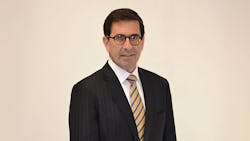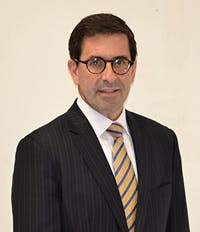Inside Track: Chris Kneizys, President/CEO of Micro-Coax (Part 2)
Download this article in .PDF format
Part 2 of 2. Check out Part 1 here.
JJD: Why is oxidation and corrosion an issue with coaxial cables?
CK: Oxidation and corrosion can be significant problems on copper and aluminum conductors. These oxides inhibit solderability, degrade the electrical performance of the conductor, and—if left to grow uncheckedcan compromise the device’s mechanical or electrical integrity. Such oxides grow most rapidly in warm and moist environments. They require the presence of oxygen in the atmosphere to corrode.
JJD: What methods exist to protect coaxial cable conductors from oxidation?
CK: Probably the most common means of protecting these materials from oxidation is through the use of barrier coatings. These coatings prevent oxygen from reaching the surface of the conductor. Such coatings include the common electroplated surface layers. For example, gold, silver, and tin are commonly used to protect less noble metals from corrosion, preserve or enhance solderability, and provide a pleasing appearance. The coatings must be thick enough to provide protection for the service life of the conductor. Often, an intermediate layer like nickel is used to reduce porosity and inhibit the migration of the basis metal to the surface.
Other barrier methods of protection include jacket extrusions or dips, which apply a polymer film to the material and therefore keep out oxygen and moisture. Coatings like benzotriazole—a transparent organic coating—temporarily exclude oxygen from the surface of the metal. Unfortunately, benzotriazole eventually evaporates and thus has a limited period of effectiveness.
JJD: What types of oxidation and corrosion protection methods exist for the typical metals used with coaxial cables?
CK: Aluminum conductors can be anodized. In this process, the surface oxide growth is actually accelerated. The resulting thick, well-formed oxide film is stable and passive. Such coatings can be transparent or colored to the end user’s specifications.
Copper and aluminum conductors are often plated for additional corrosion protection and solderability. The most common plating materials are tin and silver. Both materials are very soft and ductile. While silver has superior electrical conductive properties and is very resistant to corrosion from atmospheric oxygen, it is vulnerable to tarnish by atmospheric sulfides and nitrates. Silver plating is the preferred plating anytime the material is part of the conductive path inside the cable. For semi-rigid cables, silver-plating the outer conductor is not recommended for high-humidity or saltwater environments due to its susceptibility to galvanic corrosion or red plague.
Tin plating is economical, corrosion-resistant, and highly solderable. It is the preferred plating for semi-rigid-cable outer conductors. However, tin plating can be prone to tin whiskers. Tin whiskers are electrically conductive, crystalline structures of tin that sometimes grow from surfaces where tin is used as a final finish. They have been observed to grow to lengths of several millimeters. Tin whiskers have the potential to cause short circuits by bridging closely spaced circuit elements, which are maintained at different electrical potentials. The risk of tin whiskers can be eliminated by adding a small amount of lead to the plating, which is referred to as electro-deposited solder (EDS).
JJD: What are the effects of modifying the density and configuration of a coaxial cable’s dielectric?
CK: Low-density PTFE and ultra-low-density PTFE utilize the same base material as the full-density version, but they are processed differently. As a result of the lower density, both the dielectric constant and dissipation factor are reduced. This aspect leads to an overall lowering of the cable attenuation. The lower-density PTFEs are also more thermally stable when compared to solid PTFE. There is a tradeoff, however: Any time the dielectric density is reduced, the mechanical integrity is also reduced. As a result, cables employing a lower-density or spline dielectric will have larger minimum bend radii when compared to the solid full-density versions.
JJD: Other than PTFE, what other materials are commonly used as dielectrics?
CK: Fluorinated ethylene propylene (FEP) and Perfluroalkoxy (PFA) are two other dielectrics that are sometimes used when very thin walls are required. Examples include those on low-impedance semi-rigid cables. Both FEP and PFA have properties that are similar to PTFE.
JJD: What techniques enable the efficient automated manufacturing of coaxial cables?
CK: Mostly because of cost considerations, semi-rigid cable has found the widest adoption for high-volume applications, like consumer electronics, where automation is justified. Semi-rigid cable is selected for a number of reasons—the biggest being the fact that it is straight as opposed to coiled. This allows for precisely locating the cable, resulting in maximum tolerance control. The finished assemblies can be put on tape and reel and used with pick-and-place robots. While semi-rigid cable is the most commonly used cable for automation, high-quality cables also lend themselves to automation. They offer very tight mechanical tolerance control on the various material diameters required to operate at microwave frequencies.
JJD: What are metal-clad aramid fiber braids?
CK: For applications focused on reducing mass or increasing flex life, a process was developed to manufacture a flexible cable with a Kevlar-based, metal-clad aramid fiber braid. Known as Aracon, that braid is substantially stronger and more durable than the silver-plated copper braid wire that it replaces. Another “side benefit” of the lightweight Aracon braid is that less force is delivered to the inner and outer cable component layers during integration, flexure, and handling as compared to a metal braid. The reduction in force leads to an increased performance life for the cable.
JJD: What are the benefits and drawbacks of metal-clad fibers?
CK: The benefits of metal-clad fibers (MCF) are threefold: light weight, flexibility, and strength. MCF, when compared to copper, can reduce the weight of a braid by as much as 80%. MCF has a textile-like feel with no bend memory. It also has a flex life that is orders-of-magnitude longer than the equivalent copper wire. Besides being a good electrical conductor, MCF is metal-plated Kevlar—a material stronger than steel, which is used in bullet-resistant vests. So it can also be used as the primary strength member in any cable or harness. MCF is 10 times stronger than copper. Compared to the equivalent AWG copper wire, though, MCF will have a higher DC resistance.
JJD: How do metal-clad fibers operate for applications, such as EMI shielding, and what other applications can the material serve?
CK: The primary applications for MCF have been the outer shield of a coaxial cable and a braided or woven EMI shield for wires or harnesses. The large number of very fine fibers, together with the tendency of yarn bundles to flatten and spread, makes it easy to obtain high coverage levels with reduced windowing. Ease of pushback on the braid is maintained even at high coverage. Braids built with MCF can be soldered or crimped and are a direct substitute for copper braids built to A-A-59569. Because of the textile-like properties and strength of MCF, we are also finding applications in wearable electronics and athletic gear.
About the Author
Jean-Jacques DeLisle
Jean-Jacques graduated from the Rochester Institute of Technology, where he completed his Master of Science in Electrical Engineering. In his studies, Jean-Jacques focused on Control Systems Design, Mixed-Signal IC Design, and RF Design. His research focus was in smart-sensor platform design for RF connector applications for the telecommunications industry. During his research, Jean-Jacques developed a passion for the field of RF/microwaves and expanded his knowledge by doing R&D for the telecommunications industry.

